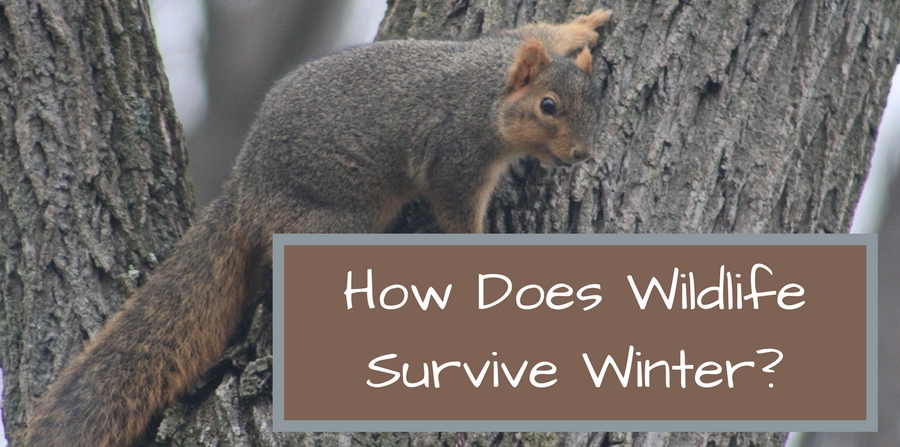If you think preparing for winter is a big hassle for you, imagine how it is for animals. They don’t exactly have the resources you do. Like a home. Or clothes. So how could they possibly get through a winter without freezing to death? How do they make sure their babies get through winter?
The answers are more varied, creative, and effective than you’d think. Life finds a way, after all. Here’s how four of Michigan’s most common wildlife species hustle their way through the coldest months of the year. After reading what these poor animals go through, you’ll never think about your home the same way again!
Squirrels
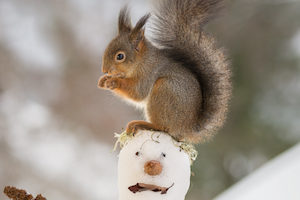 As soon as temperatures drop, squirrels scramble to collect as many nuts, berries, and seeds as they can get their paws on. You’ve probably seen the common eastern grey squirrel race around stashing every crumb of food that isn’t nailed down countless times. They stash their foraged horde in several hidden caches for when they need it. They’ll return to the stashes (well, the ones they actually remember) to snack all winter.
As soon as temperatures drop, squirrels scramble to collect as many nuts, berries, and seeds as they can get their paws on. You’ve probably seen the common eastern grey squirrel race around stashing every crumb of food that isn’t nailed down countless times. They stash their foraged horde in several hidden caches for when they need it. They’ll return to the stashes (well, the ones they actually remember) to snack all winter.
At least, they’ll go back if if they don’t gobble up the food they find before they get a chance to stash it. Squirrels are known to eat their entire body weight in a week or less in fall! By winter, most squirrels fatten up so much it’s a wonder they can move at all! Squirrels need that fat to keep them warm. Although they sleep a lot to conserve energy, very few squirrel species hibernate in winter. Even the fattest squirrel needs to wake up and munch a midwinter snacks to stay warm and healthy.
Skunks
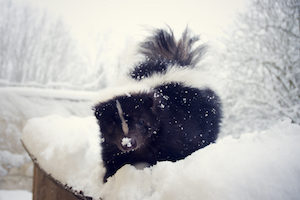 Skunks don’t horde like squirrels do, but boy do they eat. Skunks spend fall hunting and eating insects, worms, lizards, snakes, mammals smaller than them, and more. All this eating builds thick layers of fat to insulate the skunk from the cold. When winter begins, skunks usually find burrows by digging under natural or manmade cover. Many skunk species create large, multifamily burrows and keep each other warm via proximity.
Skunks don’t horde like squirrels do, but boy do they eat. Skunks spend fall hunting and eating insects, worms, lizards, snakes, mammals smaller than them, and more. All this eating builds thick layers of fat to insulate the skunk from the cold. When winter begins, skunks usually find burrows by digging under natural or manmade cover. Many skunk species create large, multifamily burrows and keep each other warm via proximity.
Contrary to popular belief, skunks don’t hibernate in winter. During the coldest times of the year, they enter a state of reduced activity called torpor. Torpor functions similarly to hibernation. The skunk enters a deep sleep, during which its metabolism drastically slows down. The big difference is, torpor doesn’t last. Like squirrels, skunks have to wake up and eat multiple times during winter to survive. When skunks wake up, they’ll take whatever food they can get. Skunks might react defensively if encountered after waking up. If you think you have a skunk spending winter under your porch, be careful!
Moles
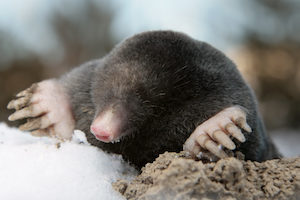 Ok, we know we said these animals solve their winter problems creatively. But, look, creativity isn’t really what moles are all about. These mammals do one thing, and they do it very well: they dig. Moles don’t stop digging, even after the ground freezes in winter. Instead, they just dig deeper. Some mole species may dig as deep as 30 inches into the earth. They can also dig complex burrows deep underground to hunt and trap their food. Like squirrels, they may even store food in these burrows for when they need it in winter.
Ok, we know we said these animals solve their winter problems creatively. But, look, creativity isn’t really what moles are all about. These mammals do one thing, and they do it very well: they dig. Moles don’t stop digging, even after the ground freezes in winter. Instead, they just dig deeper. Some mole species may dig as deep as 30 inches into the earth. They can also dig complex burrows deep underground to hunt and trap their food. Like squirrels, they may even store food in these burrows for when they need it in winter.
Most mole species seldom return to the surface during winter. They may not even be able to burrow through the hard ground. Instead, they remain in their burrows all season, relying mainly on earthworms, grubs, and subterranean insects for food. Moles rise back up through the ground as temperatures rise and the surrounding earth softens again. Sometimes, they may even return to the surface before snow melts completely.
Snakes
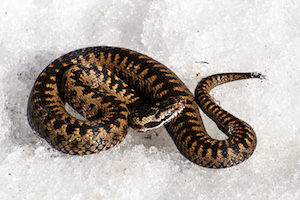 As if winter wasn’t bad enough, snakes have to contend with an extra challenge: their cold blood. As reptiles, snakes rely entirely on their surroundings to regulate their body temperatures. And they don’t even hibernate! How could something like that possibly survive winter? Instead of hibernating, snakes enter a torpor-like state of reduced activity called “brumation”. Brumation is an extreme slowing of a snake’s metabolism. During brumation, snakes can survive without eating or drinking for long periods of time. They still can’t survive freezing temperatures, however.
As if winter wasn’t bad enough, snakes have to contend with an extra challenge: their cold blood. As reptiles, snakes rely entirely on their surroundings to regulate their body temperatures. And they don’t even hibernate! How could something like that possibly survive winter? Instead of hibernating, snakes enter a torpor-like state of reduced activity called “brumation”. Brumation is an extreme slowing of a snake’s metabolism. During brumation, snakes can survive without eating or drinking for long periods of time. They still can’t survive freezing temperatures, however.
Before they enter brumation, snakes have to find or make an overwintering site called a “hibernaculum”. Brumating snakes are completely vulnerable while they sleep, so the hibernaculum has to be hidden. It can’t be out in the open, either, or the snakes would freeze. Usually, snakes burrow under existing cover like hollowed-out logs, porches, or rocks. Snakes often make hibernaculum nests in large groups, to keep one another warm. Like skunks, brumating snakes wake up periodically to seek food on warm days.
As tempting as sleeping the winter away sounds, we’re guessing you’re pretty grateful you’re not wildlife right about now. Considering how much work winter survival is, it’s hard to begrudge the pests sneaking into your home this season. Just because you understand it doesn’t mean you have to tolerate it, however.
If you have pest problems anytime this winter, give Griffin Pest Control a call right away. We’ll make sure to take care of the problem, so you can get back to surviving the winter your way–in style.

